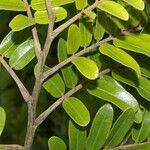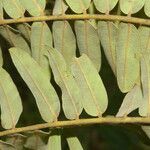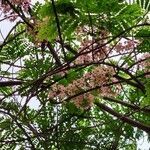Tree to 30 m., the branchlets pubescent towards the tip, later glabrous. Leaves large, many-foliolate; petiole short, eglandular, tomentose, canaliculate above; rachis up to 30 cm. long, like the petiole; stipules small, linear, caducous; leaflets up to 20 pair, oblong, 3-6 cm. long and up to 1.5 cm. wide, rounded or obtuse apically and basally, somewhat inequilateral basally, entire, tomentose below, more lightly pubescent and darker above, with about 20 pairs of lateral veins; petiolules tomentose, 1-2 mm. long. Inflorescence of several-to many-flowered racemes, axillary from older wood to subterminal; racemes to 20 cm. long, tomentose, the bracts caducous; pedicels slender, about 2 cm. long in lower flowers. Flowers showy, reported pink to white; sepals 5, unequal, oblong, the larger about 8 mm. long and 5 mm. wide, rounded apically, canescent-tomentulose without; petals ovate-orbic-ular, to 12 mm. long, short-clawed, glabrous; stamens 3-morphic, the anthers lightly pilose, the filaments glabrous; 3 lowermost stamens about 2 cm. long, the filaments gracefully arcuate and thickened towards the middle, the anthers basi-fixed, short-oblong, about 3 mm. long and 2 mm. wide, subsagittate below, de-hiscent both apically and basally; 5 median stamens about 1 cm. long, the filaments linear, the anthers ovate-orbicular, about 1.5 mm. long, more or less versatile and dehiscing basally; remaining 2 stamens rudimentary or obsolete; ovary linear, arcuate, tomentose. Legume very large, up to several dm. long and 5 cm. broad, subterete but margined, indehiscent, ligneous, transversely rugose.
More
Semideciduous tree up to 20(-30) m high; young branches and inflorescence covered with whitish rusty lanate indumentum. Leaves with 10-20 pairs of leaflets; stipules minute, triangular, subulate, early caducous; petiole 2-3 cm, lanate; rachis 10-25 cm. Leaflets subcoriaceous, subsessile, elliptic-oblong, 3-5 by 1-2 cm, rounded at both ends. Racemes lateral, 10-20 cm long, 20-40-flowered; bracts ovate-elliptic, acuminate, 2-5 mm, caducous; bracteoles similar, but smaller; pedicels 1-2 cm. Sepals ovate-obtuse, 5-8 mm, pubescent on both surfaces, finally reflexed. Petals at first red, fading to pink and finally orange, the median one red with a yellow patch, 10-15 mm, shortly clawed. Stamens 10 with hirsute anthers: 3 long with filaments up to 30 mm and anthers 2-3 mm, opening by short apical and basal slits; 5 with straight filaments, 7-9 mm and anthers 1-1.5 mm; 2 reduced with filaments c. 2 mm. Ovary tomentose, style short, stigma inconspicuous. Pods pendulous, cylindric-compressed, 20-40(-60) by 3-5 cm, keeled dorsally, woody, rugose, glabrous, blackish. Seeds 20-40, ellipsoid, flattened, surrounded by sweetish pulp, 15-20 mm.
A semi-evergreen tree. It loses some of its leaves in the dry season. It grows 20-30 m high. It spreads 5 m wide. The leaves are glossy olive green. They have a fringe of hairs along the edge. The leaves are made up of 14-42 leaflets. The flowers are in upright panicles. These are 20 cm long. They are pink. The fruit are large swollen black pods. These can be 45 cm long.





